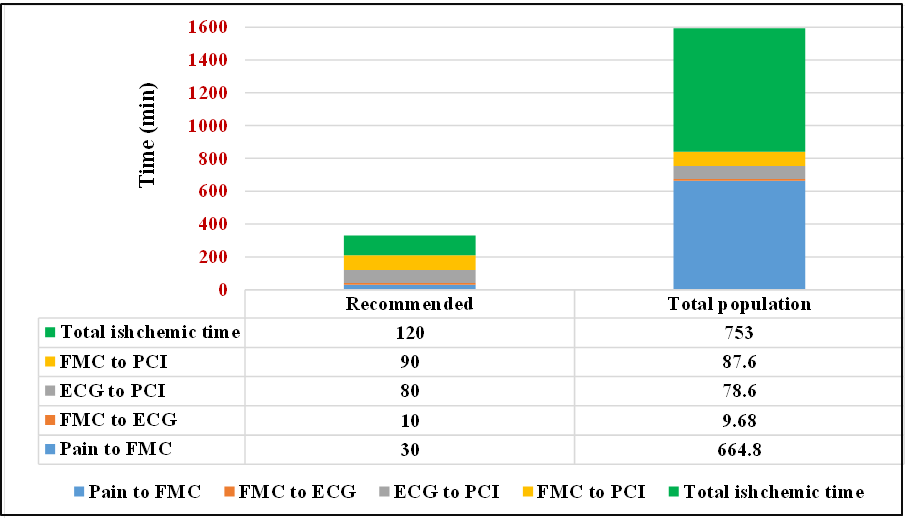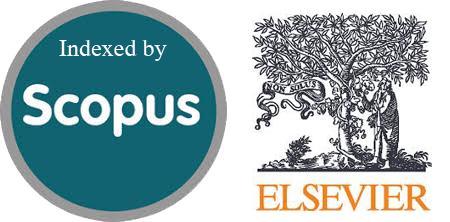Mode of Referral and Time to Primary PCI in ST-Elevation Myocardial Infarction
DOI:
https://doi.org/10.54133/ajms.v9i2.2553Keywords:
Emergency department, Ischemic time, PCI, STEMI, Transport modeAbstract
Background: ST-elevation myocardial infarction (STEMI) is a critical emergency where timely reperfusion via primary percutaneous coronary intervention (PCI) is vital. Delays in treatment, particularly during referral or transfer, can severely worsen patient outcomes. Objective: To evaluate transport modes and treatment delays among STEMI patients, focusing on critical intervals from pain onset to first medical contact (FMC) to electrocardiogram (ECG), ECG to PCI, FMC to PCI, and total ischemic time to evaluate factors influencing timely reperfusion and patient outcomes. Methods: This retrospective study included 152 STEMI patients (25–97 years) at Shar Teaching Hospital, Sulaimani, from November 2024 to May 2025. Data on demographics, transport mode, and key time intervals (pain-FMC, FMC-ECG, ECG-PCI, FMC-PCI, and total ischemic time) were analyzed. Results: Significant delays were observed in STEMI treatment processes and timelines. Pain to FMC averaged 11.08± 8.20 hours (13.8% < 30min). FMC to ECG was 9.68±2.99 min (71.7% <10min). ECG to PCI was 1.31±1.60hr (69.1% <1.0hr), and FMC to PCI was 1.46±1.59 hr (67.8% <1.5hr). Total ischemic time was 12.55±18.17 hr (4.6% <2.0 hr). Most patients (71.7%) arrived by private vehicles, while only 28.3% used Emergency Medical Services (EMS) transport, affecting outcomes. Conclusions: The study identified major delays in pain-to-FMC and total ischemic times, mainly due to low EMS use. In-hospital times (FMC-ECG, ECG-PCI) met guidelines, indicating efficient hospital care. Enhancing EMS utilization and prehospital transport could further reduce delays and improve outcomes.
Downloads
References
Pop SI, Procopciuc A, Arsintescu B, Mitariu M, Mitariu L, Pop RV, et al. Three-dimensional assessment of upper airway volume and morphology in patients with different sagittal skeletal patterns. Diagnostics (Basel). 2024;14(9):903. doi: 10.3390/diagnostics14090903. DOI: https://doi.org/10.3390/diagnostics14090903
Akbar H, Foth C, Kahloon R, Mountfort S. Acute st-segment elevation myocardial infarction (stemi). StatPearls. (2024).
Van De Werf F, Bax J, Betriu A, Blomstrom-Lundqvist C, Crea F, Falk V, et al. Management of acute myocardial infarction in patients presenting with persistent st-segment elevation: The task force on the management of st-segment elevation acute myocardial infarction of the european society of cardiology. Eur Heart J. 2008;29(23):2909-2945. doi: 10.1093/eurheartj/ehn416. DOI: https://doi.org/10.1093/eurheartj/ehn416
Antman EM, Hand M, Armstrong PW, Bates ER, Green LA, Halasyamani LK, et al. 2007 focused update of the acc/aha 2004 guidelines for the management of patients with st-elevation myocardial infarction: A report of the American College of Cardiology/American Heart Association task force on practice guidelines. Circulation. 2008;117(2):296-329. doi: 10.1161/CIRCULATIONAHA.107.188209. DOI: https://doi.org/10.1016/j.jacc.2007.10.001
Callachan EL, Alsheikh-Ali AA, Nair SC, Bruijns S, Wallis LA. Outcomes by mode of transport of st elevation mi patients in the united arab emirates. West J Emerg Med. 2017;18(3):349-355. doi: 10.5811/westjem.2017.1.32593. DOI: https://doi.org/10.5811/westjem.2017.1.32593
Stopyra JP, Snavely AC, Ashburn NP, Supples MW, Miller CD, Mahler SA. Delayed first medical contact to reperfusion time increases mortality in rural emergency medical services patients with st-elevation myocardial infarction. Acad Emerg Med. (2023);30(11):1101-1109. doi: 10.1111/acem.14787. DOI: https://doi.org/10.1111/acem.14787
Scholz KH, Meyer T, Lengenfelder B, Vahlhaus C, Tongers J, Schnupp S, et al. Patient delay and benefit of timely reperfusion in st-segment elevation myocardial infarction. Open Heart. 2021;8(1):e001650. doi: 10.1136/openhrt-2021-001650. DOI: https://doi.org/10.1136/openhrt-2021-001650
Jacobs AK, Ali MJ, Best PJ, Bieniarz MC, Bufalino VJ, French WJ, et al. Systems of care for st-segment-elevation myocardial infarction: A policy statement from the american heart association. Circulation. 2021;144(20):e310-e327. doi: 10.1161/CIR.0000000000001025. DOI: https://doi.org/10.1161/CIR.0000000000001025
Scherer TM, Russ S, Jenkins CA, Jones ID, Slovis CM, Cunningham BL, et al. Predictors of ambulance transport in patients with st-elevation myocardial infarction. Prehosp Disaster Med. 2012;27(3):226-230. doi: 10.1017/S1049023X12000696. DOI: https://doi.org/10.1017/S1049023X12000696
Najafi H, Bahramali E, Bijani M, Dehghan A, Amirkhani M, Balaghi Inaloo M. Comparison of the outcomes of ems vs. Non-ems transport of patients with st-segment elevation myocardial infarction (stemi) in southern iran: A population-based study. BMC Emerg Med. 2022;22(1):46. doi: 10.1186/s12873-022-00582-9. DOI: https://doi.org/10.1186/s12873-022-00603-x
Alghamdi AS, Alshibani A, Binhotan M, Alharbi M, Algarni SS, Alzahrani MM, et al. Shortening door-to-balloon time: The use of ambulance versus private vehicle for patients with st-segment elevation acute myocardial infarction. Open Access Emerg Med. 2023;15:457-463. doi: 10.2147/OAEM.S435446. DOI: https://doi.org/10.2147/OAEM.S435446
Sousa PJ, Teles RC, Brito J, Abecasis J, De Araújo Gonçalves P, Calé R, et al. Primary pci in st-elevation myocardial infarction: Mode of referral and time to pci. Revista Portuguesa de Cardiologia (English Edition). 2012;31(10):641-646. doi: 10.1016/j.repc.2012.05.016. DOI: https://doi.org/10.1016/j.repce.2012.08.001
Mathews R, Peterson ED, Li S, Roe MT, Glickman SW, Wiviott SD, et al. Use of emergency medical service transport among patients with st-segment–elevation myocardial infarction: Findings from the national cardiovascular data registry acute coronary treatment intervention outcomes network registry–get with the guidelines. Circulation. 2011;124(2):154-163. doi: 10.1161/CIRCULATIONAHA.110.987280. DOI: https://doi.org/10.1161/CIRCULATIONAHA.110.002345
Fu X, Wilson P, Chung WSF. Time-to-reperfusion in patients with acute myocardial infarction and mortality in prehospital emergency care: Meta-analysis. BMC Emerg Med. 2020;20(1):65. doi: 10.1186/s12873-020-00356-5. DOI: https://doi.org/10.1186/s12873-020-00356-5
Widimsky P, Wijns W, Fajadet J, De Belder M, Knot J, Aaberge L, et al. Reperfusion therapy for st elevation acute myocardial infarction in europe: Description of the current situation in 30 countries. Eur Heart J. 2010;31(8):943-957. doi: 10.1093/eurheartj/ehp492. DOI: https://doi.org/10.1093/eurheartj/ehp492
Munoz D, Roettig ML, Monk L, Al-Khalidi H, Jollis JG, Granger CB. Transport time and care processes for patients transferred with st-segment-elevation myocardial infarction: The reperfusion in acute myocardial infarction in carolina emergency rooms experience. Circ Cardiovasc Interv. 2012;5(4):555-562. doi: 10.1161/CIRCINTERVENTIONS.112.968461. DOI: https://doi.org/10.1161/CIRCINTERVENTIONS.112.968461
Scholz KH, Maier SK, Maier LS, Lengenfelder B, Jacobshagen C, Jung J, et al. Impact of treatment delay on mortality in st-segment elevation myocardial infarction (stemi) patients presenting with and without haemodynamic instability: Results from the german prospective, multicentre fitt-stemi trial. Eur Heart J. 2018;39(13):1065-1074. doi: 10.1093/eurheartj/ehy004. DOI: https://doi.org/10.1093/eurheartj/ehy004
Mehta SR, Granger CB, Boden WE, Steg PG, Bassand JP, Faxon DP, et al. Early versus delayed invasive intervention in acute coronary syndromes. N Engl J Med. 2009;360(21):2165-2175. doi: 10.1056/NEJMoa0807986. DOI: https://doi.org/10.1056/NEJMoa0807986

Downloads
Published
How to Cite
Issue
Section
License
Copyright (c) 2025 Al-Rafidain Journal of Medical Sciences ( ISSN 2789-3219 )

This work is licensed under a Creative Commons Attribution-NonCommercial-ShareAlike 4.0 International License.
Published by Al-Rafidain University College. This is an open access journal issued under the CC BY-NC-SA 4.0 license (https://creativecommons.org/licenses/by-nc-sa/4.0/).











